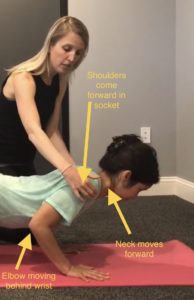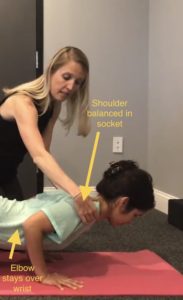
Today we’re here to talk about YOGA. At Rebalance, we see many people for head and neck issues and shoulder injuries who also practice yoga. Sometimes, the way certain yoga poses are performed can contribute to and/or exacerbate head, neck and shoulder pain. Chaturanga Dandasana is a pose that often contributes to conditions like bicep tendonitis, cervical herniation, capsular problems in the shoulder and general shoulder or neck discomfort.
Often people go into chaturanga by moving their shoulders toward their hands. When you do that, the shoulders come forward in the sockets. This position uses too much of the front of the shoulder and not enough of the back. This imbalance creates a lot of stress on the bicep tendon, the front of the shoulder and it also moves the neck forward, which strains the neck

When you go into chaturanga, you want to keep your elbow over your wrist and move forward as you lower. This will keep a neutral neck curve and keep the arm bones centered in the sockets.

Here’s an exercise you can do to start to understand the balance between some of the muscles of the shoulder. This includes the muscles in the back of the lower part of the shoulder blade, the underside of the shoulder blade and the muscles of the chest wall. When all of those muscles are working together you have a much more balanced stable shoulders.
This exercise will help you become aware of what muscles you are and aren’t using in your shoulder.
If you’re experiencing shoulder and neck issues, physical therapy coupled with medical therapeutic yoga can help you find relief. Click here to schedule a complimentary phone call to discuss your symptoms.
In-Person and Online Consultations


